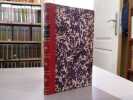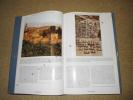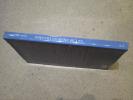-
Type
Any type (2)
Art print (7)
Book (31314)
Disk (1)
Drawings (7)
Engraving (9)
Magazine (125)
Old papers (1)
Photographs (14)
Posters (4)
-
Latest
Last 24h (7)
Last 3 days (38)
Last month (455)
Last week (41)
-
Language
Dutch (1)
English (52)
French (31387)
German (6)
Italian (18)
Portuguese (9)
Spanish (11)
-
Century
16th (15)
17th (56)
18th (213)
19th (1579)
20th (9531)
21st (1699)
-
Countries
Belgium (9489)
Brazil (7)
Canada (108)
China (1)
Côte d'Ivoire (66)
Denmark (218)
France (18483)
Germany (1)
Greece (1)
Italy (37)
Switzerland (3073)
-
Syndicate
ALAC (99)
CLAM (41)
CLAQ (94)
CNE (3)
ILAB (10920)
NVVA (1171)
SLACES (1171)
SLAM (8371)
SNCAO (9)
SAINT TUGEN et son église
1928 plaquette in-octavo, couverture grise, 62 pages, 1928 Saint-Tugen Chez lAuteur,
- monographie et explication de ses nombreux et merveilleux symbolismes, joyau architectural du cap-Sizun - sixième édition perfectionnée et augmentée - très bon état -
Saint Tugen et son église, joyau architectural du Cap-Sizun, monument historique. Monographie et explication de ses nombreux et merveilleux symbolismes
Velly Abbé Plaquette 1925 In-12 (12,7 x 18,7 cm), plaquette dos agrafé, 47 pages ; pliure au quatrième plat, par ailleurs assez bon état. Livraison a domicile (La Poste) ou en Mondial Relay sur simple demande.
L'art byzantin
Paris, Flammarion, collection La grammaire des styles, 1982, in-8 broché, 62 pp, nombreuses illustrations. Bon état.
Buch vom Werkzeug.
, Weber verlag, 1979 Hardcover with dusjacket. 479 (1) Seiten mit zahlreichen teils ganz- und doppelseitigen Abbildungen in Farbe und Schwarzwei . 34 x 26 cm, Original-Leinenband mit Deckel- und R ckentitel, Deckelillustration und farbig illustriertem Original-Schutzumschlag. Sehr gut erhaltenes Exemplar. ISBN 9783295001877.
Das Buch vom Werkzeug. Originalphotographien von Jean Marquis. Mit einem Nachwort von Serge Sautreau und Andr Velter: Das Werkzeug der Utopie. Dieses Buch entstand unter Mitwirkung von Raymond Humbert, Catharine Vaudour und Jean-Christophe Victor. Deutsche bersetzung von Gisela Umenhof.
Celtic Art
, Phaidon, 2015 240 pagina's, 255 illustraties in kleur, 29 21,4 cm, hardcover, Engels . ISBN 9780714845975.
An accessible, beautifully designed introduction to Celtic art, written by the world expert, this book offers a carefully chosen sequence of 250 masterpieces ranging from the fifth century BC to the eighth century AD. The great variety and full range of Celtic artistic production is represented ? from stone sculptures, terracotta vases and iron swords to amber necklaces, golden torques, bronze fibulas and illuminated manuscripts. Specially commissioned photography and lavish reproductions celebrate and reinforce the delicacy and beauty of Celtic art. This volume spans the entire Celtic world ? from Ireland to France, Italy to Hungary, the Czech Republic to Germany and Austria. The result is an authoritative survey of this magnificent period of artistic culture, as well as a rich visual sourcebook for students, arts and crafts lovers.
Venceslas Kruta, Germaine Leman-Delerive, Jean-Jacques Charpy, Eug ne Warmenbol, Bernard Lambot, Jeannot Metzler et Pierre Leman
Reference : 60969
Celtes: Belges, Bo ens, R mes, Volques...
, Mariemont, Couverture souple, 419 pages, Illustrated. 28cm.Texte en Francais. ISBN 2930469021.
Celtes: Belges, Bo ens, R mes, Volques.. L?ouvrage r unit des contributions originales de sp cialistes manant de plusieurs Centres de recherches. Il pr sente une vaste synth se sur l?Europe des Celtes et plus particuli rement sur l?histoire des quatre grands peuples que sont les Belges, les Bo ens, les R mes et les Volques. La partie catalogue d crit et illustre les quelque 1000 objets pr sent s dans l?exposition.
La Loggia del Capitaniato
Centro Internazionale di studi di architettura " Andrea Palladio ", VICENZA, coll. « Corpus Palladianum » 1969 Livre en italien. In-folio relié 34,5 cm sur 25. Tavole in binaco e nero di fotografie dell’interno ed esterno dell’edificio a fine volume. 10 Tavole della planimetria dell’edificio a fine volume. Planches en noir et blanc de l’intérieur et extérieur du bâtiment en fin de volume. 10 planches de la planimétrie du bâtiment en fin de volume. Jaquette en bon état. 82 pages. Très bon état d’occasion.
Monografia sulla Loggia del Capitanato a Vicenza, opera del grande architetto neoclassico Andrea Palladio. Monographie sur la Loggia del Capitaniato de Vicenza, œuvre du grand architecte neoclassiciste Andrea Palladio. Très bon état d’occasion
Disegni di monumenti storici veneziani esistenti presso il Signor Domenico Zoppetti di Venezia raccoglitore di monete medaglie, ed altre patrie antiche curiosita.
O. O., o. Vlg., (ca. 1845). Quer-Gross-8°. (1) Bl. Mit 19 Illustr. auf 11 lithogr. Tafeln von G. Draghi nach Germano Prosdocimi. lithogr. Orig.-Heft mit mont. Bibliotheksschild auf vord. Deckel (mit kl. Randläsuren, angestaubt).
Die Tafeln zeigen Wappen, Fahnen, Schwerter u.a. - Durchgehend gebräunt. - Hint. Einbanddeckel mit Knickspuren.
Bijoux Sculptures L'art vous va si bien
Gallimard, Paris, 2008. In-8, cartonnage éditeur illustré, 114 pp.
Nombreuses illustrations en noir et en couleurs. --- Plus d'informations sur le site archivesdunord.com
Phone number : 01 42 73 13 41
La peinture à venise, des origines au XVIIIe siècle.
Venezia, Edizioni Storti, 1978. 19 x 25, 128 pp., 154 planches en couleurs et le Retable d'or, broché, bon état (couverture légèrement abîmée à l'arrière).
L'escalier Minelli à Venise. Planche extraite de la publication mensuelle Croquis d'architecture, Intime-club.
- Planche autographiée. 35 x 55 cm.
Vieux papier. Croquis d'architecture, Juillet 1866.
Venise. Origine, Histoire, Vues, Monuments, Edifices publics, Description, etc.
Munich, J. Poppel et M. Kurz, 1847. In 4 (160 x 235) de 1 f. (titre), 24 planches sur papier fort sous serpentes, 128 p., 1 f. (Table). Percaline brune de l’éditeur, plats ornés d’un encadrement d’un triple filet à froid, grand fleuron doré au centre du plat sup. (Lion de Venise avec titre sur phylactère), qq. rousseurs sur les planches.
Edition illustrée de 24 magnifiques vues gravées sur acier, d’après nature. Histoire de Venise (106 p.) suivie de notices pour les gravures (pp. 107-128).
De l'ambiguïté en architecture. Collection : Aspects de l'urbanisme.
Paris, Dunod, 1984. 15 x 21, 133 pp., 350 figures, broché, bon état.
"Préface de Vincent Scully; traduit par Maurin Schlumberger et Jean-Louis Vénard."
Venturi Robert ; Scully Vincent (préface)
Reference : 115964
(1971)
ISBN : 2040005544
De l’ambiguïté en Architecture
Dunod, coll. « Aspects de l’Urbanisme » 1971 In-8 cartonnage éditeur. 22,5 cm sur 15,5. 135 pages. Nombreuses illustrations en noir et blanc. Intérieur frais. Bon état d’occasion.
Bon état d’occasion
Au pays de Madame Bovary
La Palatine 1957 In-8 broché 20,5 cm sur 14. 219 pages. 3 photographies hors-texte en noir et blanc, 3 cartes hors-texte. Manque la quatrième, le plan d’Yonville L’Abbaye. Sous rhodoïd, intérieur frais. Bon état d’occasion.
Bon état d’occasion
Vera de Lange, Oliver Kase, Daniel Koep, Thijs de Raedt, Karin Schick, Benno Tempel
Reference : 63666
UNIVERSUM MAX BECKMANN
, Waanders Uitgevers, 2024 Hardcover, 300 x 240 mm, 176 pagina's, NL edition. ISBN 9789462625280.
Ruimtelijke beleving is essentieel voor de schilder Max Beckmann (1884-1950), die tot de meest eigenzinnige en unieke kunstenaars van de twintigste eeuw behoort. De erudiete schilder ontwikkelt uit talloze bronnen - waaronder mythologie, religie en literatuur - en eigen observaties een zeer persoonlijke beeldtaal. Dit resulteert in een indrukwekkend oeuvre dat zich niet eenvoudig laat duiden, maar een sterke en mysterieuze aantrekkingskracht heeft. Beckmanns schilderijen zijn figuratief: portretten, stillevens, landschappen (met ook zee- en stadsgezichten) en mythologische en historische voorstellingen. Het vernieuwende en moderne van Beckmanns werk zit niet zozeer in zijn onderwerpskeuze, maar juist in de uitwerking ervan. Specifiek in de weergave en manipulatie van de ruimte. In dit boek en in de tentoonstelling onderzoekt Kunstmuseum Den Haag de verbeelding van de ruimte in het oeuvre van Max Beckmann: een levenslange obsessie van de schilder.
Camille Graeser. Devenir un artiste concret
, WIENAND 2020, 2020 Hardcover, 480 pages, Francais, 250 x 175 mm, Nouveau !. ISBN 9783868325805.
Camille Graeser (1882-1980) est l'un des grands artistes de Zurich. Mais comment le fabricant et designer de meubles avec son propre studio de Stuttgart en est-il venu une peinture constructive et concr te? Graeser avait accompagn son talent de peintre d s le d but et avait acquis une importance consid rable apr s sa fuite en Suisse en 1933. Ce volume d'essais d crit la p riode de bouleversements dans sa biographie ainsi que sa r orientation artistique Zurich en sept articles et l'illustre avec de nombreuses sources et archives. Ses liens avec d'autres artistes des ann es 1920 aux ann es 1950, en particulier avec les membres de l'association suisse des artistes Allianz, sont galement pris en compte. La perspective se termine par un regard sur l'engagement des jeunes artistes avec le travail de Graeser.
Vera Hausdorff, Roman Kurzmeyer, Eugen Gomringer, Hans-Dieter Huber, Rudolf Koella, Antje Krause-Wahl
Reference : 53636
Camille Graeser. The Making of a Concrete Artist
, Wienand Verlag, 2020 Hardcover, 480 pages, mit 321 farbigen und 91 s/w illustr . 24,5 x 17,0 cm Text ENGLISH ISBN 9783868325799.
Camille Graeser is one of the great concrete artists from Zurich. But how did the furniture maker and designer with his own studio in Stuttgart come to create concrete, constructivist painting? Graeser?s talent as a painter accompanied him from the beginning and gained importance after his flight to Switzerland in 1933. This essay volume describes the period of upheaval in his biography as well as his artistic reorientation in Zurich and illustrates this with extensive source and archive material.
Merveilleuses Cartes a Jouer du XIXe Siecle
Paris, Nathan, 1989 Couverture reliee sous jaquette 191 PAGES. Illustrated. ISBN 9782092901571.
Monographie de la CHARTREUSE de Marseille.
Alexandre Geuidon Marseille 1860 In-8 ( 200 X 130 mm ) de 190 pages, demi-maroquin framboise, dos lisse orné de filets et fleurons dorés, pièce de titre de maroquin olive ( Reliure de l'époque ). Photographie en frontispice. EDITION ORIGINALE. Très bel exemplaire, très frais. De la bibliothèque Ernest DE CROSET ( Ex-libris ).
Kölner Kirchen. Die kirchliche Baukunst in Köln von den Anfängen bis zur Gegenwart.
Köln, Greven, 1969. Petit in-4 reliure éditeur pleine toile sous jaquette illustrée, 73 pp., 159 pl. d'ill. photogr. en noir, plans dans le texte.
Accrocs au bord de la jq., ouvrage en très bonne condition. - Frais de port : -France 6,9 € -U.E. 11 € -Monde (z B : 18 €) (z C : 31 €)
Knowing (by) Designing
, Ku Leuven Luca, 2013 Softcover, 819 pages, 17cm x 25cm, English text. ISBN 9789081323864.
Verbiest Dirk / Eneman Lieze Lieze Eneman Rik Pinxten Patrick van Rossem Nicola Setari Roland Jooris Ulrich Loock
Reference : 48453
Museumcultuur Strombeek/Gent
, MER Paper Kunsthalle, Softcover, 383 pagina's Illustrated. NL- ENG. ISBN 9789492321008.
Overzichtswerk met werken ge xposeerd in 2013 en 2014, tijdens 4 projecten (met werk van oa Franz West, Daniel Buren, De Keyser, Honore dO, Willy De Sauter, Jef Gheys, AV Janssens, Sol LeWitt, Richter, Warhol, van Severen, Marthe Wer, Lawrence Wiener, en zoveel meer gecureerd door Philippe Van Cauteren, Nicolas Setari en Luk Lambrecht. Het boek toont de werking van deze samenwerking tussen 2013 en 2014. er wordt geput uit de rijke collectie van het SMAK, en privecollecties, en nieuwe producties van actuele kunstenaars, die tentoongesteld worden in het CC Strombeek, dat zo de museumwereld binnenbrengt in een Cultureel Centrum.
Oscar Verpoorten schenking Simona Verpoorten.
, Scheepvaart museum Antwerpen, 2016 softcover, 25.5 x 24.5 cm.32 pagina's full color.*nieuw. ISBN 9789078656005.
catalogus met tekeningen en schilderijen boten en schelde zicht.
La Cité idéale en Occident.
Philippe Lebaud Philippe Lebaud, 1996, 206 p., cartonnage éditeur sous jaquette, environ 34x21cm, bords de la jaquette froissés par endroits, bon état.
Merci de nous contacter à l'avance si vous souhaitez consulter une référence au sein de notre librairie.
 Write to the booksellers
Write to the booksellers









